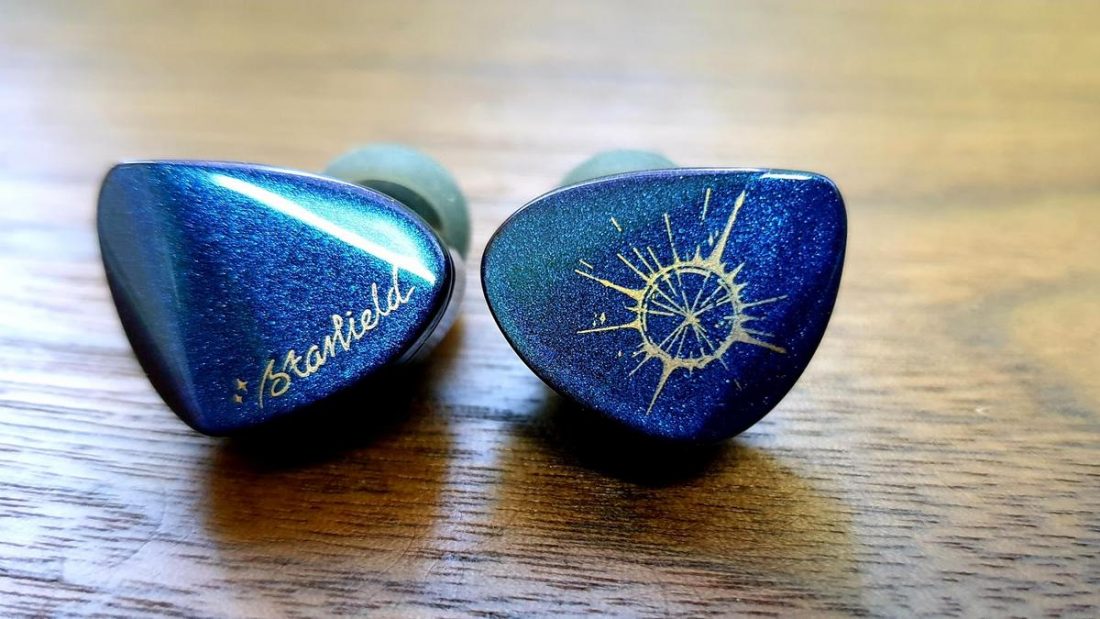An entry-level earphone with its head in the stars, the Starfield is a value proposition by Moondrop, a company that seems to do no wrong (just yet). It’s time to dive headfirst into the universe of Moondrop’s enchanting tuning.
“Catch a falling star and put it in your pocket, never let it fade away.” You’ve heard of a star fall, but how about a moon drop? Moondrop is part of the brigade of “holy crap, there they are again” fast-rising brands in Chi-fi, along with Fearless, Tin HiFi and the like. I’m sure there are others, but these three brands release new stuff at such a breakneck pace, it’s as if their lives depended on it.
- Value for money
- Eye-watering design
- Excellent build quality
- Assured fit and great comfort
- Good isolation
- Well-implemented (if modified) Harman tuning
- Fluid, coherent tuning
- Beautiful mids
- Even treble response
- Soundstage size and imaging
- Too much competition in this price bracket
- Fragile cable
- Midbass bloat and bleed
- Bass speed and texture
- Overall sluggish transient response
- Treble is a bit too safe

That Guy Again
Their IEM tuning is famously based on the Harman Target Response Curve. They take a can’t-fail, research-based tuning recipe, apply a few tweaks, scour the earth for drivers that do the best job for the price, before unleashing a full range of IEMs from entry-level to flagship. And here’s the thing, they are remarkably consistent in what they do. I’ve never heard a badly-tuned Moondrop yet.
Today we look at their entry-level model, the Starfield. Powered by a single carbon nanotube (CNT) driver (ok just a variation of the dynamic driver), the Starfield (rhymes with Garfield) is marketed as the musical, easy-listening complement to the incisive, reference-tuned KXXS.
I’m always tickled by CNT drivers because it’s one letter away from the most offensive word in English.
It’s can’t. Can’t is a horrible four-letter word.
The Starfield is available via Moondrop’s official Amazon and AliExpress pages. I’d like to extend my sincere thanks to Moondrop for the review unit and their patient communication.
Equipment Used:
DAP
IEMs
- Moondrop Starfield
- Tanchjim Oxygen
Albums
- Aaron Neville – Warm Your Heart
- Bruno Mars – 24K Magic
- Fleetwood Mac – Rumours
- Hozier – Wasteland, Baby!
- Jill Barber Band – Mischievous Moon
- Macy Gray – Stripped
- Michael Jackson – The Essential
- Taylor Swift – 1989
- The Dark Knight: Original Motion Picture Soundtrack – Hans Zimmer & James Newton Howard
- The Eagles – Hell Freezes Over
Technical Specifications
- Driver: 10mm dual cavity Carbon Nanotube (CNT) diaphragm
- Sensitivity: 122dB/Vrms @1kHz
- Impedance: 32Ω±15% @1kHz
- Frequency Response: 10Hz – 36kHz
- Effective frequency response: 20Hz – 20kHz (IEC60318-4)
- Connector: 2-pin 0.78mm
- Cable Length: 1.2m
- Cable Material: 24AWG Litz 4N Oxygen-Free Copper (OFC)

Packaging and Accessories
The midnight blue cable looks like a variant of the generic Plastics One cable, with a handsome splitter of the Moondrop logo the only notable difference. I like the paint job, and at this price I shouldn’t complain, but I’d definitely like to see a thicker, higher quality stock cable.
Design and Build Quality
The Starfield is essentially the KXXS with a coat of woohoo paint. As a refresher, the shells are made of zinc/aluminum alloy, with a crease down the middle separating two halves. The angular faceplate exclusive to itself and KXXS, like brothers from a different mother. Wait, it’s the same mother. Being metal, they are heavy for their size, but are a joy to handle, and wins durability points.
But here the star (sic) of the show is the “special painting tech” which coats the Starfield in a glittery navy blue/purple gradient. The colors change as you rotate the earpiece, and sparkles under a light source. The Starfield reflects a lot of light thanks to the angled faceplate, highlighting the intricate, innate beauty of the shells. This is vanity of the highest order, and I love it!
They should market the Starfield with Coldplay’s “A Sky Full of Stars”, because those words describe their looks best.

Fit, Isolation, and Comfort
The Starfield softly whispers in my ear.
“I’m going to slide in now, ok?”
“Will it hurt?”
“No. Trust me.”
“Sure thing, sweetheart.”
“I forgot to bring lube!”
And in goes the small but sturdy earpiece into my ears. The faceplate might have all the funny angles, but the inner surface of the Starfield is smooth and seamless throughout. They fit comfortably, and despite being made of metal, stay put most of the time. The stock tips provided an excellent seal, top marks for that.
Dang Cats
The Starfield has two vents on each earpiece, but despite that, isolate better than expected. I thought I would hear my colleague chew from across the room, or the randy cats outside the office, even with music at full blast. But lo and behold, the Starfield was able to block out as much as 70% of external noise, even the cats. This might be because the vents are at the inside surface of the shells.
Sound Quality
The Starfield is but a blip in a sky of budget Chi-fi IEMs, so what matters most is the sound, for a good tuning echoes in eternity. Or more accurately, rides the hype train a while longer.
Overall Sound Signature
According to Moondrop, Starfield’s tuning is based on the Harman target response curve, but with a few adjustments. What I hear is a fuller midbass and lower mids section compared to the other Harman-neutral IEMs, essentially making this a warm Harman, if such a term exists. I’ll call it the Warman Harman.
This particular beast veers close to L-shaped territory, owing to the boosted sub-bass and midbass, mildly elevated upper mids and lower treble, and a neutral mids response. Put together though, it’s a fun and agreeable tuning with emphasis on round, full-sized notes, with a soft and delicate touch.
Put Away the Knife
This will not scrutinize nor slice through your music with the exactness of a paring knife, the Starfield is more like a big spoon that stirs all musical elements into a big pot for a harmonious broth. The best part is, the soundstage is large enough so the music doesn’t blend into a mess, like when you mix more and more colors and eventually everything becomes brown. A space oddity this is not.
Listening Conditions
Critical listening was done after 50 hours of burn-in, breaking down this stubborn CNT and rendering it a submissive, blubbering mess. I hear no difference after burning in though, so make of it what you will. The main review rig is Sony’s NW-WM1A Walkman modded by Project K, using the stock cable and stock medium tips.

Bass
Across the universe, the stars crash and collide… in star wars. I’ve always wanted to say something epic and cheesy. The bass likes to think in grand proportions too, settling for nothing less than thick, full and rounded notes ad infinitum. The sub-bass reach is impressive, delivering boisterous and ballsy blows. It’s a welcome rush to the ears whenever the sub-bass bellows in full glory.
The midbass doesn’t shy away from the action either, and carries on the foundation laid by the sub-bass. It starts with rounded-off attacks, followed by a hefty note body, and finished with a smooth, lingering decay. Notes are punchy and physical, delivering might and fury whenever needed. It’s Thickasaurus time, all right!
Thickasaurus
Predictably, you know where this leads. The bass is heavy-handed, bloaty, and at times overwhelming. Bass speed, texture, detail and layering all take a back seat to the almighty full-on bass attack. This is not your textured, layered bass, but a fun, take-no-prisoner boom-boom Becker bass, that bleeds unapologetically into the mids after one too many drinks.
Mids
Picture a geyser, a waterfall, or a virgin gir… scratch that. The Starfield mids are so fluid, they might as well be wet.
The calm, assured flow of one note to the next is so buttery and eloquent it’s like Bruce Lee standing next to you saying “be water, my friend”.
The after-effect of the midbass hump is a plump, luscious lower mids section. Male vocals have a bellowy, weighty edge, while bass guitars and cellos have an authoritative body. The middle to upper mids leave me spellbound, with sufficient richness to sound luxuriant, yet enough air to sound ethereal. Strings and female voices affect me as if they were real.
Spellbound
Notes have the right thickness, and decay with a gentle flutter. The texture is fine as silk, with nary a hint of grain. Transient response is, predictably, a bit sluggish, but coherence is just about perfect from the lower mids to the upper. Aided by the Harman curve or not, the mids are tuned wonderfully and a worthy highlight. It’s time to yield and be healed by the majesty of the Starfield.

Treble
Like dipping your French fry in ice cream, the Starfield treble is a crispy snack wrapped in layers of creamy smoothness. Like the rest of the signature, the treble is playful with a side of mischief. With a nice bump in the lower treble, notes are quite energetic and airy. Cymbals and hi-hats have an audible crunch and good shimmer, with details to spare.
Fullasaurus
At the same time, there is a fullness to the notes that prevent the treble from sounding brittle or too airy. The solidity and smooth flow of the notes dial back the flippancy and adds a dash of seriousness, like putting glasses on a toddler. Before the notes take flight in a flurry of sparkle and air, gravity and weight make sure the notes are well-fed at the start.
The extension is alright, with a dip starting in mid-treble. Some treble-heads might want a dangerous, strident treble with more glory and panache, but for the most part, the Starfield is executed well, with musicality and agility in equal measure, if a bit too safe.
Soundstage and Imaging
Space… is as big as it gets. You think of the planets, the cosmos, the reaches of the sky we have yet to discover… I’d like to say Starfield’s soundstage is like its namesake, but that’d be an outright lie. But still, it’s quite good, better than many in its price range, with a width that’s more appreciable than its depth and height.
Importantly, notes have space to play and breathe, and a good amount of air tails behind. Except for the midbass, you’ll never accuse the Starfield of sounding congested. Imaging does its job, with well-defined cues in all three axes. You relax and drift away as the music envelops you and unfolds naturally.
It’s like sitting in the front row of a performance, not as engaging as onstage, but you won’t miss anything either.

Comparisons
Tanchjim Oxygen
As you may know, Oxygen was a hit-or-miss, save for the brilliant mids. But does that mean I dislike the Harman tuning as a whole? This then, is the litmus test, a tale of two Harmans. We might never know what a verbatim Harman tuning sounds like, since Sean Olive and company came up with the frequency graph but left the IEM-building to other manufacturers.
So implementation of the graph becomes paramount, and Oxygen’s hollow lower mids and treble bluntness killed most of my love for it. Still, Starfield, at less than half the price of the Oxygen, seems to have a mountain to climb. The Starfield already has a leg up with a more attractive design, scratch resistance, and better fit, but it’s all about the sound.
Two Harmans
Comparing the two, you hear similarities in tone. The boosted bass, forward mids and natural, realistic timbre are the main selling points of both, but there are many differences to be had as well. Although both are tuned to be smooth and tuneful, Oxygen on the whole is more resolved and immediate, while Starfield is more open and laid-back.
Oxygen is better extended in the sub-bass with a more visceral response, while Starfield has a much meatier and engaging midbass, sometimes to its detriment. Oxygen’s main weakness, the recessed lower mids robs male vocals and plucked strings of body and presence. Starfield glides through this area effortlessly, with a fullness that Oxygen can only be envious of.
Duel of the Dynamics
The highlight of both IEMs are in the mids, and are equals in tone, note density, and lushness. However, Oxygen is more aggressive and forward, and can be shouty and raspy especially in the upper mids. Starfield is more controlled and refined throughout, with an airy finish to the notes that’s never harsh.
Starfield’s playful treble is shimmery with plenty of air, while you already know I don’t like Oxygen’s. Crucially, Starfield has a much larger soundstage, lending a more spacious and calmer presentation. I can wade through any musical mess with ease, while Oxygen just sounds suffocated at times.
It seems you have to look to the stars for answers, and to me it’s clear. Starfield is simply a better-tuned IEM.

Final Words
Starfield, high yield, a stellar earphone is now unveiled. If you’ve ever wanted a taste of the Harman tuning on a budget, this is an outstanding example. Starfield has many things in its favor to illuminate the price bracket, particularly the luscious, warm signature that soothes the soul. The marvelous starstruck design is just the cherry on top.
Pale Moonlight
Sometimes though, there is no happy ending. The Starfield, as good as it is, might get lost in a tsunami of similarly-priced Chinese-made IEMs, especially when dozens are rolled-out every month. The worst part is, the standard of budget has been raised for some time, and it is harder to find a genuinely bad IEM these days.
What Starfield has going for it is Moondrop’s name recognition, spotless reputation, and tuning mastery to weather through the Chi-fi storm. The Starfield will appeal to many with its pleasing, mellifluous tuning, but is that enough to stand out and last beyond flavor-of-the-month (FOTM) status? Only time will tell.

If William Faulkner or Cormac McCarthy wrote audio reviews I doubt they’d exceed
the standard set in the writings of Lau.
I own the Starfield iem and it’s impossible to feel cheated.
I’m grateful I’ve lived long enough to see a world in which sonic splendor is so
inexpensive and aesthetically realized.
Thank you for your decorative dialogue and incisive prose!
Cheers
Terribly sorry for the late reply, but your kind words are deeply felt, and much appreciated. Thank you again.
Esto mas que una review me pareció mas un poema hacia un audífono titulado starfield azul estrellado el sonido de la eternidad XD ejejejejej. siempre me saltan las dudas al comprar audífonos, en especial cuando tienen este costo pues es como como diría Forrest Gump La vida es como una caja de bombones, nunca sabes lo que te va a tocar, en este caso audífonos o son una maravilla o son una porquería, mi duda seria como se compara con los fiio fh3.
If you don’t mind my asking, what’s the difference between the starfield and the stardust? I keep seeing that it’s a reskin of the ssr, but I can’t be sure.